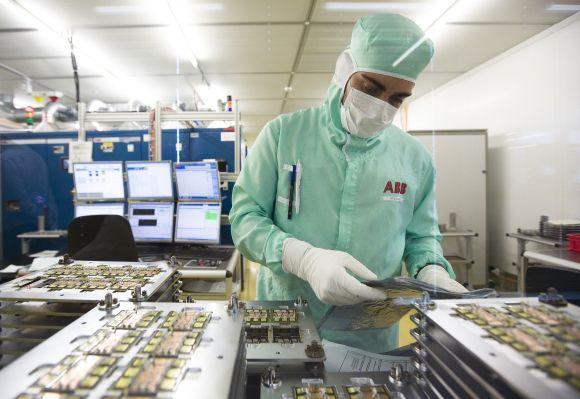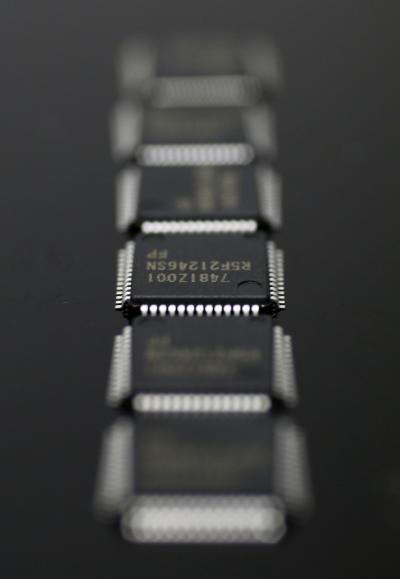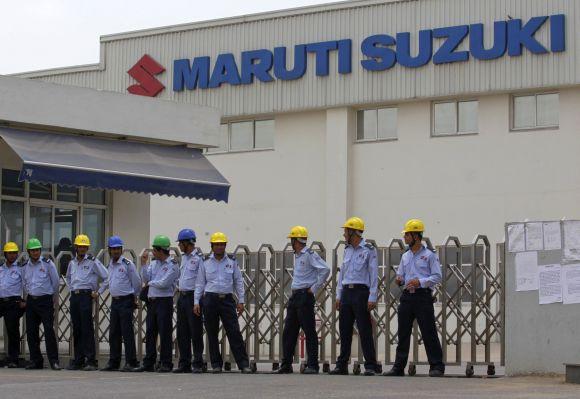 | « Back to article | Print this article |
Why it's difficult for India to manufacture chips
The country lacks infrastructure required for making chips. The government, however, can use auto sector as a model to frame the right policies.
Doubts about India's wafer fabrication ambitions were epitomised in a recent New York Times article on India's computer hardware manufacturing ambitions ("India, Long the Home of Outsourcing, Now Wants to Make its Own Chips").
The New York Times' global edition, International Herald Tribune, carried a more pointed title: "Doubts Grow Over India's Computer Ambitions".
Despite a false note in the print version mis-stating India's electricity generation capacity, the article underlines the difficulties in such an undertaking in India because of the lack of infrastructure, and questions the efficacy of mandated local sourcing.
Do or die
Does this mean that we should abandon aspirations of wafer fabrication? Or should we concentrate on fixing these problems instead?
The New York Times article provides a compelling reason for changing our game from disjointed aspirations and scattershot efforts to focused, goal-oriented, convergent planning and execution: India's electronics import demand, now $70 billion, is projected to quadruple by the end of the decade, exceeding oil imports.
Click NEXT to read more...
Why it's difficult for India to manufacture chips
If there is no augmentation of domestic hardware capacity, growth will probably be strangulated.
The article's warning, that efforts at a high-tech revolution may fail unless India reduces barriers to doing business, is spot on. No amount of traipsing around the globe on roadshows selling India can substitute for correcting this.
Our need, therefore, is to create conditions that are conducive to the development of an ecosystem for hardware manufacturing. One question is whether domestic purchasing mandates ("preferential market access") help or hinder this process.
In contrast to its otherwise downbeat tone, the article mentions the success of automotive manufacturing in India.
The question is whether the government can identify the policies that resulted in this success, and succeed in replicating or creating analogous policies as appropriate for computer hardware.
Automotive manufacturing and local sourcing
Maruti Udyog Ltd was the first modern car manufacturer in India, established as a joint venture between the government and Suzuki Motor Corporation in 1981.
Click NEXT to read more...
Why it's difficult for India to manufacture chips
While production started in 1983 with a group of follow-source suppliers (Japanese manufacturers supplying parts to their client at a different location) and some local manufacturers, it took over a decade for domestic content to reach 85-90 per cent.
By 2000, however, new models were aiming for this level of domestic sourcing after one year.
This is because the government dismantled some protective mechanisms shielding domestic manufacturers from foreign competition, and introduced a package of investment incentives, domestic manufacturing requirements, export incentives, duty drawback schemes and tariffs in the 1990s.
Simultaneously, there was a perceived rise in demand. These factors led transnational manufacturers to invest to meet local demand as well as exports, with a combination of follow-source suppliers together with local manufacturers.
Policies to promote local production and sourcing, therefore, contributed significantly to the rise of the automotive sector, although there were other contributory factors.
This experience can be drawn on to promote domestic hardware manufacturing, while limiting the extent to which follow-source suppliers exclude local manufacturers.
Click NEXT to read more...
Why it's difficult for India to manufacture chips
For instance, in the case of Volvo trucks, international follow-source suppliers dominated local supply, blocking opportunities for domestic suppliers.
An ecosystem for hardware manufacturing
There's no getting away from the need for basic infrastructure. A wafer fabrication unit requires not only its infrastructure for operations, but also across its markets, meaning the whole country, for domestic sales.
This means countrywide electricity and other forms of energy (gas, petro-products, coal, and renewables such as solar and wind energy), water and sewerage, roads and other modes of transportation, and communications.
In broad terms, our governments (central and states) and society simply have to engage in disciplined, systematic institutional efforts to build infrastructure in an integrated manner, instead of patchwork fixes.
This is not feasible in the short run; even over time, vague aspirations will not do. We need to put in consistent effort for years on phased planning-cum-rigorous-execution on a massive scale.
Click NEXT to read more...
Why it's difficult for India to manufacture chips
For wafer fabrication, a cluster approach, as for automotive manufacturing, that builds on existing capacity could provide a feasible method - for example, locating the facility near an existing cluster where infrastructure is more readily available, as are people with the requisite skills.
Institutions for systematic development
Evidence of the critical importance of institutions for prosperity was reaffirmed in a study published in 2000, "The Colonial Origins of Comparative Development: An Empirical Investigation", by Daron Acemoglu, Simon Johnson, and James A Robinson.
This study suggests that in places where colonisers settled, such as Australia, New Zealand, Canada and the US, they tried to replicate European institutions, emphasising private property and checks against government power.
In places considered unfavourable for settlement like India, they created exploitative (or "extractive") states and institutions, which persist.
The study documents that "settlements were a major determinant of early institutions ... that there is a strong correlation between early institutions and institutions today; and finally that current institutions have a first-order effect on current performance".
Click NEXT to read more...
Why it's difficult for India to manufacture chips
A recent book by two of these authors builds on their findings (Why Nations Fail, Daron Acemoglu and James Robinson).
It has been written up in two very informative reviews in this newspaper. Any responsible policy making or criticism of policies needs to take these ideas into account as contributive factors.
The way to develop infrastructure systematically is through sound institutions, of necessity with finite near-term coverage, gradually extending their scope over time.
As mentioned in a previous article, institutional development of communications and requisite energy systems are arguably the most appropriate ways to embark on this process.
There are no short cuts to building good institutions. We have to reconfigure our exploitative, post-colonial holdovers, to refashion institutions as competent, fair, collaborative systems.
The problem is that predatory elites have to either voluntarily relinquish control or be persuaded to do so in favour of open systems, instead of forcing us to go through escalating chaos, outrage, and, ultimately, a violent upheaval.
shyamponappa@gmail.com






